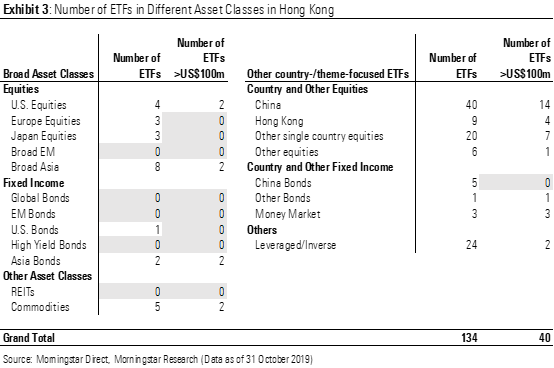In part 1 of this article, we shared the first 10 observations about the Tracker Fund of Hong Kong and the HK ETF market. Here we will share the rest of 10 facts and thoughts.
Hong Kong ETF Market
11. Transaction Value
According to statistics from the HKEx, the average daily turnover of ETFs for the first ten months of 2019 was HK$4.5 billion. - This accounted for 5% of the average daily turnover by value on the securities market of the HKEx.
12. ETF Providers
There are now 23 ETF providers with ETF listings in Hong Kong. – Nikko Asset Management and Premia Partners were prominent new-comers in the Hong Kong ETF market in the past three years.
13. The Mix – Asset Class
Looking at the Hong Kong-listed ETF menu through the lens of a local investor trying to build a diversified portfolio, it is clear that broad-based fixed income products are a gap in the local menu. - If we put asset size considerations into place (say, screening for funds with AUM of US$100 million or more), the gap becomes even larger as product availability is skewed towards China-focused products.

14. From Plain Vanilla to Leveraged/Inverse
Leveraged/inverse products were first introduced in Hong Kong in June 2016. The rules were recently relaxed to also allow 2x inverse products. The first such product was launched in March 2019. - For most investors, leveraged/inverse products are generally not suitable as buy and hold investments. In general, they are more suitable for traders who understand how leveraged/inverse ETFs work as a short-term trading and speculation tool and for investors looking to use them as a short term-hedge.
15. From Passive to Active
Regulations specific to active ETFs in Hong Kong came into force as of the beginning of 2019. The first active ETF in Hong Kong was listed in June 2019. The fund offers exposure in the USD money market. – Active ETFs only accounted for a small portion of the U.S. ETF market, at around 2% in asset under management as of end-October 2019.
16. What’s Missing?
The product menu is just one area of the Hong Kong ETF market that could use more attention. Last year, we wrote an article “Twenty Years On, There Are Still Plenty of Gaps to Fill in the Asian ETF Menu”. In our view, other missing ingredients from the Asia region’s growth recipe still apply to Hong Kong, namely – Investor education; distribution; and scale.
17. Missing Ingredient #1 - Investor Education
According to the “Retail Investor Survey 2019” published by the HKEx in May 2019, “ETP are gaining popularity with around 15% of the Hong Kong population being ETP investors.”. This compares to a reading of 7% in 2011. However, this is far less than the 56% figure for stocks. Anecdotally, retail investors in Hong Kong are generally unfamiliar with ETFs and the pros and cons of using them in a portfolio. – We believe investor education is important for retail investors, especially as it pertains to how ETFs can be used to invest for retirement and in MPF schemes in particular.
18. Missing Ingredient #2 - Distribution
Morningstar published the “Global Investor Experience Study: Fees and Expenses” in September 2019, we noted fund distribution in many Asian markets, including Hong Kong, is dominated by local banks that do not have an incentive to sell ETFs to individual
Investors. – A shift to fee-based advisory that we have seen in other markets, such as the U.S. and Australia, could help the further development of the ETF market.
19. Missing Ingredient #3 - Scale
The Asia ETF market is very fragmented. This limits the scalability and local rules and regulations could limit accessibility of different products to investors in the region. – We believe ETF passporting schemes among a wider network of markets within the region could increase the overall size of the market and allow ETFs to ultimately achieve economies of scale. The connectivity of the ETF markets in Hong Kong and mainland China remains an area where industry participants see huge opportunities.
20. Future of the HK ETF Market
Hong Kong is uniquely positioned, especially given its proximity to China. With China further opening up its capital market Hong Kong’s ETF ecosystem can capture the upcoming opportunities while tackling any potential challenges and obstacles. In addition, ETFs are a global product and globalization can likely bring ETFs closer to investors’ doorstep. Exchanges and ETF providers will need to continue to adapt in order to provide the best products to global investors. - Only the best products for investors can survive for the long run.
















